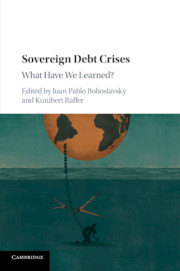Book contents
- Sovereign Debt Crises
- Sovereign Debt Crises
- Copyright page
- Dedication
- Contents
- Contributors
- 1 Introduction
- 2 Managing Public Debt Crisis in Argentina
- 3 Why Developing Countries Should Not Incur Foreign Debt
- 4 Ecuador’s 2008–2009 Debt Restructuring
- 5 Greece: An EU-Inflicted Catastrophe*
- 6 Grenada: A Small Island Developing State Needs New Ways Out of Its Debt
- 7 Iceland: A Human Rights-Sensitive Approach to Deal with Financial Crises
- 8 Indonesia’s 1997–1998 Economic Crisis
- 9 The Irish Sovereign Debt Crisis Post-2009
- 10 Short-Term Capital Controls and Malaysia’s Fast Recovery after the East-Asian Crisis
- 11 Sovereign Debt
- 12 Portugal’s Austerity Bailout
- 13 Don’t Waste a Serious Crisis*
- 14 Lessons from South Korea
- 15 The Spanish Crisis
- 16 Conclusions
- Index
9 - The Irish Sovereign Debt Crisis Post-2009
A Lesson on Why Countries Should Never Enter into Unsustainable Currency Unions
Published online by Cambridge University Press: 16 November 2017
- Sovereign Debt Crises
- Sovereign Debt Crises
- Copyright page
- Dedication
- Contents
- Contributors
- 1 Introduction
- 2 Managing Public Debt Crisis in Argentina
- 3 Why Developing Countries Should Not Incur Foreign Debt
- 4 Ecuador’s 2008–2009 Debt Restructuring
- 5 Greece: An EU-Inflicted Catastrophe*
- 6 Grenada: A Small Island Developing State Needs New Ways Out of Its Debt
- 7 Iceland: A Human Rights-Sensitive Approach to Deal with Financial Crises
- 8 Indonesia’s 1997–1998 Economic Crisis
- 9 The Irish Sovereign Debt Crisis Post-2009
- 10 Short-Term Capital Controls and Malaysia’s Fast Recovery after the East-Asian Crisis
- 11 Sovereign Debt
- 12 Portugal’s Austerity Bailout
- 13 Don’t Waste a Serious Crisis*
- 14 Lessons from South Korea
- 15 The Spanish Crisis
- 16 Conclusions
- Index
Summary
Prior to the financial crisis of 2008 Ireland tended to run fiscal surpluses and have low government debt-to-GDP. But after the banking system blew up as a Minskyian property bubble unwound government debt skyrocketed as the government absorbed private sector debts. From a sectoral balances perspective what effectively occurred was that the government sector forced the private sector into borrowing by running public budget surpluses. When the private sector debt became unsustainable it was then forced back onto the public balance sheet. The Irish government was forced into backstopping the debt that had originated in the banking system. We now have clear evidence that public officials were effectively forced into accepting the debt by European and international institutions and threatened when they indicated possible non-compliance. Because the Irish central bank had been stripped of its money-issuing capacity the Irish government was placed in a position of powerlessness where it had to concede to any and all demands lest the economy be starved of liquidity and brought to a standstill. At the same time, the rise in interest rates on government bonds that triggered the sovereign debt crisis would never have occurred had the Irish central bank retained its money-issuing capacities. The Irish sovereign debt crisis was generated by Ireland’s adherence to the European monetary union’s neoliberal policy stance, as enshrined in documents like the Maastricht Treaty, together with their ceding control over money-issuance to non-elected, centralized authorities. Today there is the possibility that some of this debt might be written down but without an aggressive turn towards expansionary fiscal policy far outside of Maastricht Treaty limitations, full employment is unlikely to be achieved. The most rational path for Irish policymakers to undertake would be a managed exit from the single currency accompanied by a temporary peg to either the British sterling or the US dollar.
- Type
- Chapter
- Information
- Sovereign Debt CrisesWhat Have We Learned?, pp. 143 - 162Publisher: Cambridge University PressPrint publication year: 2017



